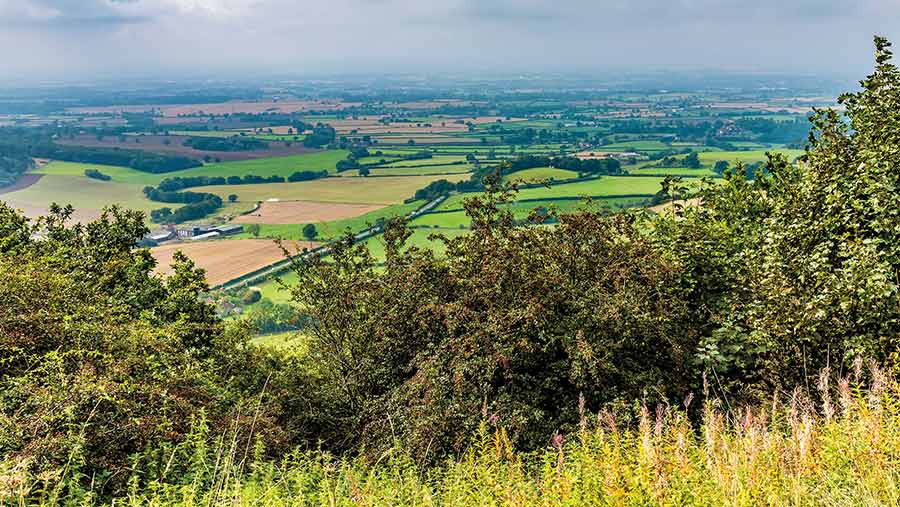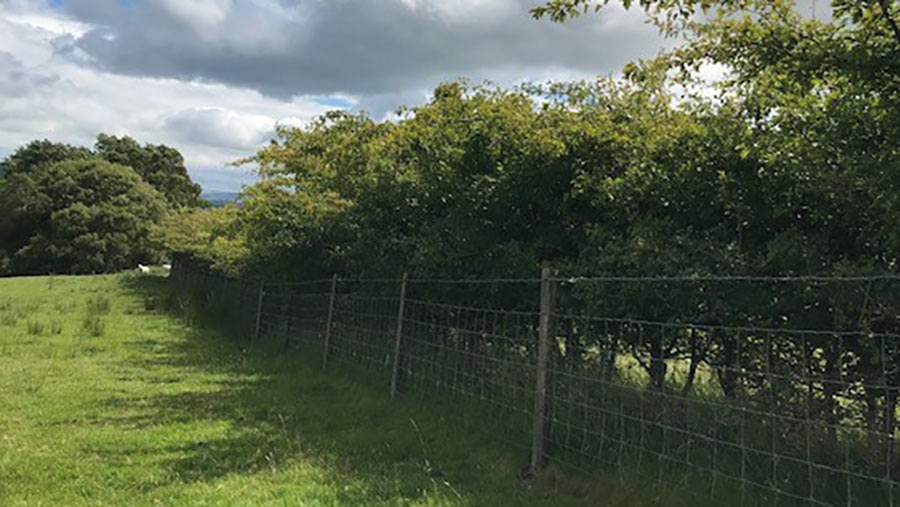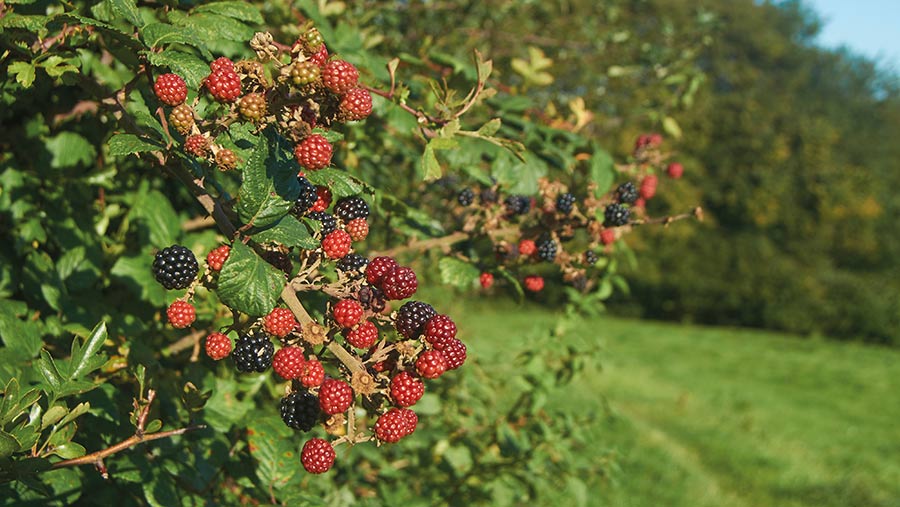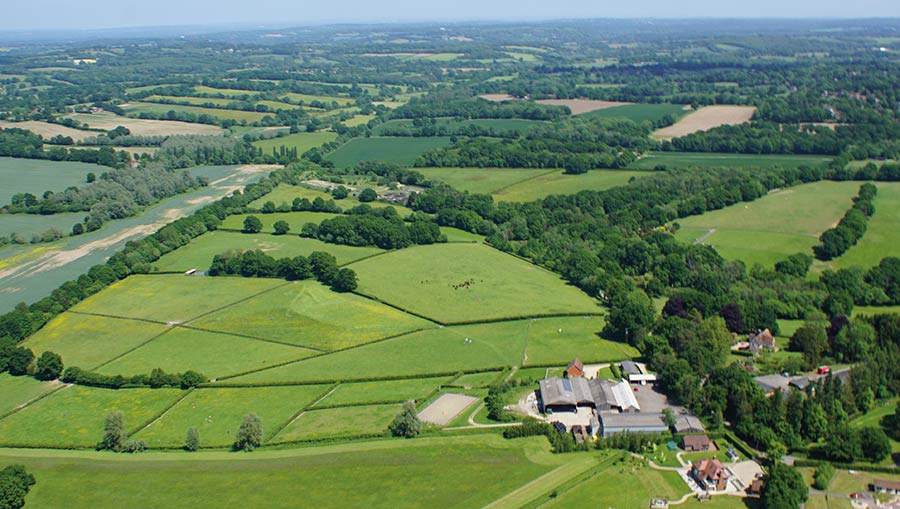Strong farmer support for hedge planting – if it pays
 © Nicola/Adobe Stock
© Nicola/Adobe Stock There are numerous misconceptions about farmers and farming, but one of the most common has to be in relation to hedgerows.
The view still held by much of the general public is that farmers are wantonly destructive, grubbing up hedgerows with gay abandon as they push for bigger fields, economies of scale and increased profit – whatever the cost to the environment.
See also: How hedge management can increase revenue and biodiversity
Of course, there was a period just after the Second World War when some of this was true.
In the quest to rebuild food production in the 1950s and 1960s, farmers were even paid to take out hedges – and Forestry Commission estimates suggest about half of the country’s 1m kilometres of hedgerows were lost as a consequence.
But the 1997 Hedgerow Regulations made it an offence to remove hedgerows in most circumstances, and various agri-environment schemes have since rewarded farmers for new plantings, with many thousands of kilometres of hedges reinstated in recent years.
While this message has not always got through, the reality is that farmers are more than happy to deliver for the environment, whether in response to market signals or just through their own altruism.
Farmers surveyed
To better understand the relationship between farmers and hedges, Farmers Weekly joined forces with CPRE, the countryside charity, to quiz industry stakeholders through an online survey.
In total, more than 1,100 farmers and land managers took part, covering the whole range of farm enterprises, and all areas of the country – though with a particularly strong representation from the South West, a region renowned for its iconic network of hedgerows.
Encouragingly, almost 60% of farmers said they had planted new hedgerows in the past 10 years, with almost two-thirds of those having been put in in the past three years.
Not surprisingly, larger-scale farmers tended to have planted longer distances, though the average length of new planting was just over 600m.
Much of this has been done without any outside support, with 44% of farmers and landowners paying for hedgerow creation from their own accounts.
For the 56% who have done it in response to financial incentives, the most common source (72%) has been government funding, such as Countryside Stewardship and Higher-Level Stewardship schemes.
However, one-quarter said they had received private funding, while others had benefited from charity support.
Outlook
The trend towards reinstating hedges is very much a “work in progress”, with 63% of farmers saying they are either “likely“ or “very likely” to plant more on their farms over the next five years.
This reflects the importance they attach to having hedgerows.
Asked to select their top five benefits, the most popular answer (86%) was to provide habitat and corridors for wildlife, followed by affording shelter and shade for livestock and crops, and a home for pollinators.
Other benefits included keeping livestock secure, improving the beauty of the farm, keeping trespassers out and carbon capture.
Barriers
Hedge planting is something the CPRE is keen to encourage, so understanding the key barriers and drivers is important in terms of lobbying for continued and, hopefully, additional support.
The survey asked farmers and landowners to name their top five barriers to doing more hedgerow planting – and not surprisingly, the answers were nearly all financial.
The most common response was the cost of establishment, with 70% mentioning this as a barrier to further planting.
This was followed by the lack of both time and money, and then the costs associated with managing newly planted hedgerows.
The potential loss of land and production was also mentioned, as was the nature of government support.
This last point suggests some disillusionment and confusion with the variety of support schemes on offer, be it Countryside Stewardship, Environmental Stewardship and now the emerging Environmental Land Management scheme in England.
It was therefore little surprise to see “providing simple, accessible schemes” was the second most popular response after “government incentives” in answer to the question “What would encourage you to plant more hedgerows?”
Case study: Geraint Davies, Bala, North Wales
With a mix of sheep and cattle run over 485ha of organic upland and hill ground in the Snowdonia National Park, plus 12ha of ancient oak woodland, Geraint Davies’ ethos is to farm “as close to nature as possible”.
He believes that producing food and a thriving natural environment go hand in hand, while ensuring the business is financially viable.
Hedgerow management forms a key part of this strategy, and the farm has a mix of old and new hedgerows, with some turning into lines of trees.

Hedgerows maturing at Geraint Davies’ upland farm © Geraint Davies
The hedgerows are managed by laying and some coppicing. It takes time, but they will grow to become a solid boundary and wildlife habitat.
Mr Davies also opts for more delicate management in places – for example, protecting ground-nesting birds by reducing perch points for predators.
There is also a lot of new planting, with some 14km of hedgerows put in or restored over the past 15 years.
This has been done with the help of grant aid – a “win-win” for a livestock farmer who wants to both produce food and care for the environment.
Livestock are usually housed over the winter, but where there are more established hedgerows providing shelter from the weather, stock can be kept outside for longer and turned out earlier in the spring.
Given that housing animals costs the business an estimated £150/day for silage and shelter, having them outside sooner and longer is a big money saver.
“The farm has been transformed,” says Mr Davies. “Birds and nature are using the hedgerows, and I want to pass it on to the next generation like this.”
With an eye to the future, Mr Davies also plans to make some fields smaller again by splitting them up with new hedgerows, with the aim of making rotational grazing easier to manage.
“If farmers want to benefit from future farming policies, it’s not about reinventing the wheel, but learning about what people want to achieve and having policies about restoring what was once there,” he says. “At the end of the day, the focus is on producing food and caring for the environment in equal measure.”
Management matters to optimise hedges
When it comes to managing hedgerows, as opposed to just planting new ones, the survey again showed active participation by the vast majority of farmers and landowners.
The most common practice was “rotational management” – in other words, trimming hedges once every two or three years – mentioned by just over half of respondents, though a similar proportion also said they engaged in annual cutting of some hedgerows.
“Gapping up”, planting hedgerow trees and hedge laying were also undertaken by 30-40% of respondents.
The main reason for doing so was to benefit wildlife and improve hedgerow structure, the survey revealed.
But the pride farmers take in their hedges was also made clear in some of the additional comments provided.
“I planted my hedges up to 60 years ago and have some of the best in my neighbourhood, and I am very proud of what I have done,” said one smaller-scale farmer from the South West.
“We wanted our hedgerows to be thicker at the base to provide greater benefits for nature, so we only cut them on one side for four years in a row. We now have lovely, thick hedgerows, but it is disappointing that this approach isn’t currently supported financially by the government,” said a larger-scale farmer from the South East.
When asked how they would like to manage their hedges if they could do it differently, the most popular ambitions were to do more hedge laying and to provide more hedgerow trees.
But there are challenges.

© Jeremy Richards/Adobe Stock
“Finding time and resources to restore the hedges that need it is a constant worry,” said one smaller-scale East Anglian farmer. “I wonder what state they will be in to pass on to the next generation.”
Asked what help they would prefer to encourage better management, money came out on top, with regular payments and capital grants cited by 64% of respondents as key for making improvements.
This was roughly three times the number who wanted one-to-one advice and training.
Perhaps surprisingly, there was relatively little objection to the August hedgecutting ban – introduced by Defra in 2015 under cross-compliance rules to delay the start of cutting by a month to benefit late-nesting birds.
While there has been vocal opposition to this by contractors, keen to get on the land and start trimming, the majority of respondents to the survey (72%) said meeting this condition presented few problems.
Support for hedge expansion
The CPRE charity is campaigning for a 40% expansion of hedgerows by 2050 – as recommended by the Climate Change Committee. We asked farmers if they would support this goal if it was properly funded through Environmental Land Management or other government policies.
Key survey findings
- The vast majority (85%) of farmers believe hedgerows are important to them and their farm businesses
- Overall, six in 10 have planted some hedgerows in the past 10 years, with about two-thirds of those planting up to 500m
- 70% of respondents would plant more hedgerows with government incentives
- 86% of farmers surveyed see wildlife habitat/nature corridors as the top benefit of having hedgerows
- Two-thirds of respondents cut their hedgerows from September to November
- Most hedgerow management takes the form of rotational care and annual trimming, but one-third would like to change how their hedgerows are managed
Case study: Kevin Hawes, East Sussex
Nightingale Farm, near Hartfield in East Sussex, overlooks the upper Medway valley and, in the past, would have been typical of others in the High Weald – undulating land broken up into a patchwork of small fields, deep-set lanes and the remnants of ancient woodland.
But much of this changed in the 20th century, as the need to grow arable crops more efficiently led to fields being enlarged, so much of the old hedgerow pattern was lost.

New hedgerows have been created at Nightingale Farm © Kevi Hawes
After buying the farm in 2003, first-generation farmer Kevin Hawes decided to return the farm to grassland, planting hedgerows to provide shelter for his Sussex cattle and Southdown sheep, creating smaller fields for rotational grazing, and substantially improving the landscape.
So far, he has planted more than 30,000 hedgerow plants, 20,000 of them under a Countryside Stewardship agreement.
These include hawthorn and blackthorn for the main structure of the hedge, plus field maple, hazel, guelder rose, dogwood, spindle and dog rose.
The hedges are flail-cut annually, at the right time of year to protect nesting birds, with the contractor cutting a little higher each time, so the hedges get slightly taller.
Hundreds of metres of hedge have also been traditionally laid by hand.
Mr Hawes sees his hedgerows as an excellent network for wildlife. Butterflies proliferate, and an RSPB survey has identified a wide variety of red-listed birds.
“It’s great for wildlife and, with the Ashdown Forest nearby and a network of woodland all around, we are completing a patchwork of habitats that would once have existed across the High Weald,” he says.
Planting and managing hedgerows is time-consuming and expensive, so to encourage more uptake by other farmers, Mr Hawes is an advocate of local funding initiatives, as well as national programmes.
But he finds the new approach to rural funding confusing, with few options for permanent grassland farms.
The current shift towards Environmental Land Management only seems to cover the cost of, rather than the delivery of, public goods, while progressive cuts to the Basic Payment Scheme will undermine the viability of small-scale livestock farming.
Mr Hawes feels the new schemes need to do more to offer sufficient rewards to maintain the sustainable and environmentally sensitive farming which is essential in areas such as the High Weald.
Thanks to the CRPE for making this article possible. Farmers Weekly had full editorial control.
‘Time for more support’
“With the new Environmental Land Management [ELM] scheme in development, it is a crucial time for hedgerows and their role in supporting food production, reversing the decline of nature and delivering net zero,” says Tom Fyans, interim chief executive at CPRE, the countryside charity.
“We therefore need to ensure farmers and land managers are properly incentivised to enhance hedgerow networks through well-designed and accessible agri-environment payment schemes, and that hedgerows are recognised as an essential part of both the continuity and transformation of British farming.
“While recognising that agriculture is a devolved matter, our report highlights a number of important recommendations for the Westminster government, including setting a national target to increase the hedgerow network by 40% by 2050, designing and resourcing ELM to deliver a healthy expanded hedgerow network, and increasing capital funding for hedgerow planting and restoration at farm and landscape scale.”

